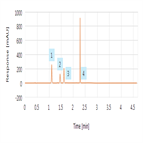Find methods for your needs
Refine by Feature
Displaying 1-5 of 11 results for Tag: Veterinary Drug
Fast separation of coccidiostats
Instrument Type: UHPLCTo demonstrate how the use of alternate UHPLC stationary phase selectivities can facilitate method speed up and as a result this sample throughput was tripled compared to the legacy methods with an associated five-fold reduction in cost per sample for optimized method
AN348: Extraction of Anthelmintic Drugs from a Veterinary Formulation Using Accelerated Solvent Extraction (ASE)
Instrument Type: Automated Sample PrepIsolation of the active drug from some veterinary formulations can be difficult because the matrix is often complex. Automated Solvent Extraction (ASE 350) technique is an automated method that uses the smaller amounts of solvents with more efficient extractions at less time than the traditional extraction methods. This application note describes the extraction of the two active species of ivermectin (H2B1a and H2B1b), an anthelmintic drug, from a veterinary formulation containing dried meat products. The drug is prescribed for heartworm treatment in cats and dogs.
AN326: Extraction of Drugs from Animal Feeds Using Accelerated Solvent Extraction (ASE)
Instrument Type: Automated Sample PrepASE is widely used in the environmental industry to replace time- and solvent-intensive techniques such as Soxhlet and sonication extraction. Many features of the ASE system also make it attractive for use in pharmaceutical laboratories. This Application Note gives two examples of how ASE can provide extraction efficiencies superior to other techniques. In the first example, ASE is used to extract an antischizophrenic agent from rodent feed used in drug testing. In the second example, ASE is used to extract Lasalocid, a veterinary medicinal added to poultry and cattle feed.
Full-Scan Fragmentation Options for the Detection of Food Contaminants by an Affordable LC-Q-Orbitrap MS
Instrument Type: LCMSThe analysis of food toxicants is challenging because of the high number of substances that need to be analyzed. Pesticides alone account for over 800 analytes including other types of toxicants such as mycotoxins, plant toxins and/or veterinary drugs. The use of liquid chromatography with full-scan, high-resolution accurate mass spectrometry (HRAM) as an alternative is gaining in popularity. We compare two different scan options of a quadrupole-Orbitrap system, both offering full mass range fragmentation techniques, and to optimize performance in terms of sensitivity and selectivity
Determination of a Single Methodology for the Analysis and Quantitation of Multiclass Veterinary Drugs in Different Animal Matrices Used for Consumption
Instrument Type: LCMSMSVeterinary drugs are pharmacologically active compounds that can result in non-desirable drug residues in the food chain. Animals with high amounts of these drugs can cause harm in humans or can render the use of antibiotics useless due to the counter effects of the drugs. The quantification of over 200 multi-class veterinary drugs from different meat products usually involves time consuming extraction methods with either SPE or LLE. We describe a robust method, utilizing a single LC-MS/MS run to quantitate over 200 veterinary drugs in a variety of matrices.





